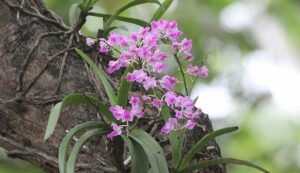Assam: Orchid forest at Rangajan in Jorhat is in bloom, with over 9,000 copo flowers in bloom
Jorhat: Carefully tended by farmer and ardent nature lover Mithu Gogoi, Jorhat is a stunning marvel nestled in the verdant surroundings of Rangajan. It is home to over 9,000 Kopou Phool (Rhynchostylis retusa) in a lively orchid forest.

Since 2013, Gogoi has turned his lifelong passion for the natural world into a flourishing conservation initiative that has captivated the interest of travelers, scientists, and orchid enthusiasts all across India.
Gogoi’s garden has become a sanctuary for the Kopou Phool, which is renowned for its strong scent and cultural importance in Assamese customs. Women wear it most often during the Bihu festival.
“First of all, I welcome you all here,” said Mithu Gogoi, a farmer and environment lover, in an interview with ANI. Being surrounded by nature since I was a little kid has always influenced my ideas and views. I made the decision to save the Kopou phool (Rhynchostylis retusa) because of this link. I started growing Kopou phool in my yard in 2013, and it has now grown into a colorful orchid forest.
“In my orchid garden, we have around 325 species of orchids, but what truly sets it apart is the 9,000 Rhynchostylis retusa, commonly known as Kopou Phool, that we have preserved here,” he said.
Gogoi, who is a nature lover and a farmer, said, “We did not collect these orchids from the wild; instead, we rescued them from residences, buildings, and other urban environments and carefully relocated them to our garden.”
“I haven’t been cultivating and storing these flowers for business. In the past, we exported these orchids to other nations and sold them in Assam, India. We now only sell in Assam and a few other regions of India, however, since our distribution lines were shut down during the COVID outbreak. These flowers have been greatly impacted by climate change. You see, orchids typically blossom during this season, but only about half of them have done so so far because of climate change. These orchids are being preserved by me alone. This is one of my own goals and interests. He said that neither the government nor any other organizations had given him any assistance.
“For research objectives, organizations such as the Regional Research Laboratory and Assam Agricultural University have been to my garden. Visitors from all around the nation often come here, as do students from different universities and institutions. However, my garden has not yet been visited by international visitors. We are not permitted to maintain endangered orchid species due to government rules. Only saved orchids are preserved here. The farmer who loved the outdoors said, “We don’t gather orchids from the wild.”

